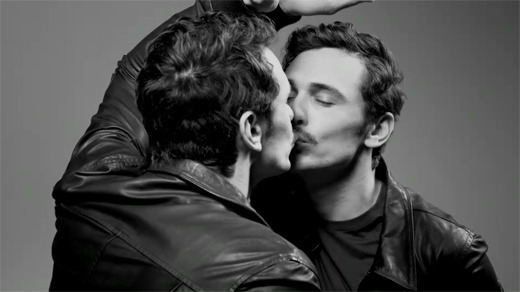
In a new interview with The Daily Beast, James Franco opens up about what draws him to gay roles and stories.
This year alone, Franco has starred in 10 films and directed three, adding to his queer repertoire (which includes acting in Howl, Milk and The Broken Tower and two features he directed: Interior. Leather. Bar and the Sal Mineo biopic Sal, which is based on Michael Gregg Michaud’s book Sal Mineo: A Biography).
Sal tells the story of the Rebel Without a Cause actor who was nominated for two Oscars before he turned 20 and whose career faded as he attempted to transition from child to adult roles and became one of the first Hollywood stars to come out of the closet as gay.
On Sal: Sal was a teen star, and I think there were three reasons that his star faded: 1) he got older, and child actors always need to transition to adult roles, which is difficult for them; 2) he sort of came out of the closet, which probably wasn’t helpful for his career; 3) he did a couple of movies that were controversial at the time, which tainted his image a little bit. In one of those films, Who Killed Teddy Bear, he pumps iron and it’s a very earnest fetishizing, so I got the idea [of having the opening scene of Sal be him pumping iron] from that. Sal did care about his looks, and his career was as a heartthrob actor, so the way that he earned his living was based on his physical beauty. So, it’s about an artist who can’t practice his art the way he once did, and the sadness of that, but that he never stopped trying. The workout scene is to show that he’d hit his ceiling — but not for lack of effort.
On playing his gay heroes: It’s not like it’s my mission to tell the stories of as many gay men as possible, although in some cases, I think it is the point. In Milk, the point is to show one of the great fighters for equal rights for the gay community, so I was happy to do that. With characters like Allen Ginsberg [in Howl], my love for him started with his work when I was a teenager. So his sexuality is secondary to me. It’s an important aspect of who he was and his character, but it wasn’t like, “Yes, I want to play another gay role,” it was more, “Yes, I’d love to play another one of my heroes.”
Once I choose a subject, if that’s part of who they are and their character, I’m not going to shy away from portraying that. And of course I’m for equal rights and will do whatever I can do to help make that happen. But I feel like because I’ve done more gay characters, gay scenes, or gay projects than most straight actors, people see it as some sort of mission. It’s more of a case-by-case basis, and just trying to capture figures that I love. I guess that a lot of the figures that I love were gay.
 Why you can trust Xtra
Why you can trust Xtra


